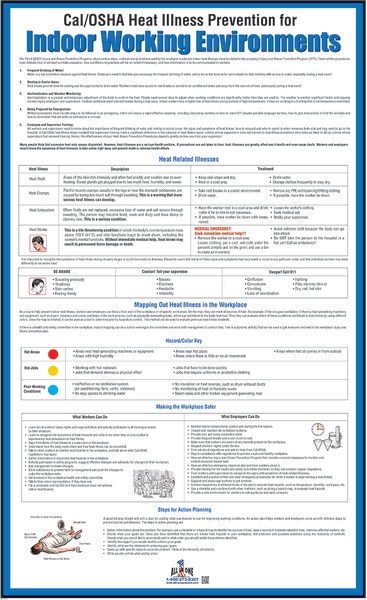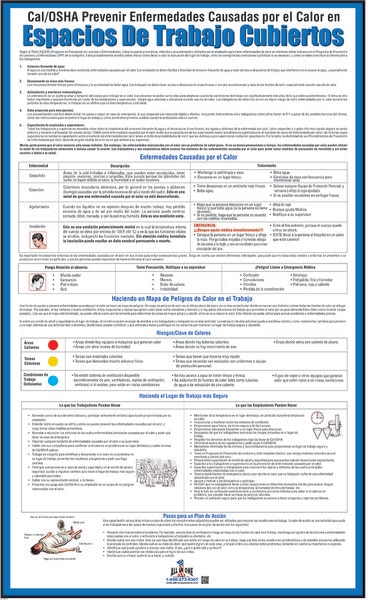California Indoor Heat Regulation
California Indoor Heat Regulation: Keeping You Cool and Safe Summer in California can bring scorching temperatures that can pose risks to your health and well-being. To ensure that workers stay cool and safe in indoor environments, the state of California has implemented regulations for Indoor Heat Illness Prevention. In this post, we will dive into the details of these regulations, provide helpful tips to beat the heat, and address frequently asked questions. So, grab a cold drink, relax, and let's explore how to stay cool this summer! 1. Understanding the California Indoor Heat Regulation The California Indoor Heat Regulation is a set of guidelines designed to protect workers from excessive heat exposure in indoor workplaces. These regulations were put in place to prevent heat-related illnesses and injuries by ensuring that employers take necessary actions to maintain cool temperatures and provide appropriate accommodations for workers. 2. Key Requirements of the Regulations To comply with the California Indoor Heat Regulation, employers must implement certain measures to mitigate heat-related risks. Some of the key requirements include: 2.1. Temperature Control: - Employers must ensure that indoor working areas are maintained at a comfortable temperature, typically set below 80 degrees Fahrenheit. - Adequate air conditioning or ventilation systems should be installed to achieve and maintain this temperature. 2.2. Access to Shade and Cool Areas: - Employers must provide workers with access to shaded or cool areas for relief. - These areas should allow employees to take rest breaks and recover from heat exposure. 3. Implementing the Regulations in your Workplace If you are an employer or supervisor, here are some practical tips to help you implement the California Indoor Heat Regulation effectively: 3.1. Regular Temperature Monitoring: - Set up systems to continuously monitor the indoor temperature. - Use reliable temperature gauges and thermometers to ensure accurate readings. 3.2. Provide Adequate Ventilation: - Install air conditioning units or fans to circulate cool air. - Regularly inspect and maintain these systems to ensure optimal performance.  4. Employee Training and Education To protect your employees from heat-related illnesses, it is crucial to provide comprehensive training and education. Here are some points to cover during the training sessions: 4.1. Recognizing the Symptoms: - Teach your employees about the signs and symptoms of heat stress, heat exhaustion, and heat stroke. - Make sure they understand the importance of reporting any discomfort or dehydration immediately. 4.2. Hydration Guidelines: - Educate your workers about the significance of staying hydrated. - Promote regular water breaks and provide access to clean drinking water. 4.3. Personal Protective Equipment (PPE): - Train employees on the appropriate use of PPE in hot environments. - Highlight the importance of wearing lightweight, breathable clothing and protective gear.
4. Employee Training and Education To protect your employees from heat-related illnesses, it is crucial to provide comprehensive training and education. Here are some points to cover during the training sessions: 4.1. Recognizing the Symptoms: - Teach your employees about the signs and symptoms of heat stress, heat exhaustion, and heat stroke. - Make sure they understand the importance of reporting any discomfort or dehydration immediately. 4.2. Hydration Guidelines: - Educate your workers about the significance of staying hydrated. - Promote regular water breaks and provide access to clean drinking water. 4.3. Personal Protective Equipment (PPE): - Train employees on the appropriate use of PPE in hot environments. - Highlight the importance of wearing lightweight, breathable clothing and protective gear.  5. Frequently Asked Questions about Indoor Heat Regulation 5.1. Q: Which industries are covered under the Indoor Heat Regulation? A: The regulations apply to a wide range of industries, including warehouses, factories, retail, and construction sites. 5.2. Q: What should I do if I notice high temperatures in my workplace? A: Inform your supervisor or employer immediately. They are responsible for taking appropriate steps to address the issue. 5.3. Q: Are there any penalties for non-compliance with the regulations? A: Failure to comply with the California Indoor Heat Regulation can result in penalties and fines for employers, depending on the severity of the violation. Conclusion: The California Indoor Heat Regulation is an essential component of ensuring the safety and well-being of workers in indoor environments. By understanding and implementing these regulations, employers can create a comfortable and safe working environment, reducing the risk of heat-related illnesses. Remember, staying cool and hydrated is not just a luxury; it's a necessity to keep California's workforce healthy and thriving. Stay cool and be safe this summer! Disclaimer: The content provided in this article does not constitute legal advice. Please refer to the official California Department of Industrial Relations website for the most up-to-date information on the California Indoor Heat Regulation.
5. Frequently Asked Questions about Indoor Heat Regulation 5.1. Q: Which industries are covered under the Indoor Heat Regulation? A: The regulations apply to a wide range of industries, including warehouses, factories, retail, and construction sites. 5.2. Q: What should I do if I notice high temperatures in my workplace? A: Inform your supervisor or employer immediately. They are responsible for taking appropriate steps to address the issue. 5.3. Q: Are there any penalties for non-compliance with the regulations? A: Failure to comply with the California Indoor Heat Regulation can result in penalties and fines for employers, depending on the severity of the violation. Conclusion: The California Indoor Heat Regulation is an essential component of ensuring the safety and well-being of workers in indoor environments. By understanding and implementing these regulations, employers can create a comfortable and safe working environment, reducing the risk of heat-related illnesses. Remember, staying cool and hydrated is not just a luxury; it's a necessity to keep California's workforce healthy and thriving. Stay cool and be safe this summer! Disclaimer: The content provided in this article does not constitute legal advice. Please refer to the official California Department of Industrial Relations website for the most up-to-date information on the California Indoor Heat Regulation.  Image Source : indoorcannabis.org
Image Source : indoorcannabis.org  Image Source : newsable.asianetnews.com
Image Source : newsable.asianetnews.com  Image Source : www.allinoneposters.com
Image Source : www.allinoneposters.com  Image Source : www.pinterest.co.uk
Image Source : www.pinterest.co.uk  Image Source : www.allinoneposters.com
Image Source : www.allinoneposters.com  Image Source : dailytechu.com
Image Source : dailytechu.com  Image Source : www.ostsinc.com
Image Source : www.ostsinc.com  Image Source : www.pressdemocrat.com
Image Source : www.pressdemocrat.com
Image 1: Proposed Regulation: Indoor Heat Illness Prevention
 4. Employee Training and Education To protect your employees from heat-related illnesses, it is crucial to provide comprehensive training and education. Here are some points to cover during the training sessions: 4.1. Recognizing the Symptoms: - Teach your employees about the signs and symptoms of heat stress, heat exhaustion, and heat stroke. - Make sure they understand the importance of reporting any discomfort or dehydration immediately. 4.2. Hydration Guidelines: - Educate your workers about the significance of staying hydrated. - Promote regular water breaks and provide access to clean drinking water. 4.3. Personal Protective Equipment (PPE): - Train employees on the appropriate use of PPE in hot environments. - Highlight the importance of wearing lightweight, breathable clothing and protective gear.
4. Employee Training and Education To protect your employees from heat-related illnesses, it is crucial to provide comprehensive training and education. Here are some points to cover during the training sessions: 4.1. Recognizing the Symptoms: - Teach your employees about the signs and symptoms of heat stress, heat exhaustion, and heat stroke. - Make sure they understand the importance of reporting any discomfort or dehydration immediately. 4.2. Hydration Guidelines: - Educate your workers about the significance of staying hydrated. - Promote regular water breaks and provide access to clean drinking water. 4.3. Personal Protective Equipment (PPE): - Train employees on the appropriate use of PPE in hot environments. - Highlight the importance of wearing lightweight, breathable clothing and protective gear. Image 2: Climate | KQED
 5. Frequently Asked Questions about Indoor Heat Regulation 5.1. Q: Which industries are covered under the Indoor Heat Regulation? A: The regulations apply to a wide range of industries, including warehouses, factories, retail, and construction sites. 5.2. Q: What should I do if I notice high temperatures in my workplace? A: Inform your supervisor or employer immediately. They are responsible for taking appropriate steps to address the issue. 5.3. Q: Are there any penalties for non-compliance with the regulations? A: Failure to comply with the California Indoor Heat Regulation can result in penalties and fines for employers, depending on the severity of the violation. Conclusion: The California Indoor Heat Regulation is an essential component of ensuring the safety and well-being of workers in indoor environments. By understanding and implementing these regulations, employers can create a comfortable and safe working environment, reducing the risk of heat-related illnesses. Remember, staying cool and hydrated is not just a luxury; it's a necessity to keep California's workforce healthy and thriving. Stay cool and be safe this summer! Disclaimer: The content provided in this article does not constitute legal advice. Please refer to the official California Department of Industrial Relations website for the most up-to-date information on the California Indoor Heat Regulation.
5. Frequently Asked Questions about Indoor Heat Regulation 5.1. Q: Which industries are covered under the Indoor Heat Regulation? A: The regulations apply to a wide range of industries, including warehouses, factories, retail, and construction sites. 5.2. Q: What should I do if I notice high temperatures in my workplace? A: Inform your supervisor or employer immediately. They are responsible for taking appropriate steps to address the issue. 5.3. Q: Are there any penalties for non-compliance with the regulations? A: Failure to comply with the California Indoor Heat Regulation can result in penalties and fines for employers, depending on the severity of the violation. Conclusion: The California Indoor Heat Regulation is an essential component of ensuring the safety and well-being of workers in indoor environments. By understanding and implementing these regulations, employers can create a comfortable and safe working environment, reducing the risk of heat-related illnesses. Remember, staying cool and hydrated is not just a luxury; it's a necessity to keep California's workforce healthy and thriving. Stay cool and be safe this summer! Disclaimer: The content provided in this article does not constitute legal advice. Please refer to the official California Department of Industrial Relations website for the most up-to-date information on the California Indoor Heat Regulation. California Cannabis Regulation Proposal - Indoor Cannabis
California Reintroduces Mask Regulation For Indoor Public Venues Till
 Image Source : newsable.asianetnews.com
Image Source : newsable.asianetnews.com California Indoor Heat Stress | CAL-OSHA Safety Poster For Workplace
 Image Source : www.allinoneposters.com
Image Source : www.allinoneposters.com heat stress indoor california yet reviews
Climate | KQED
 Image Source : www.pinterest.co.uk
Image Source : www.pinterest.co.uk California Indoor Heat Stress | CAL-OSHA Safety Poster For Workplace
 Image Source : www.allinoneposters.com
Image Source : www.allinoneposters.com california stress heat indoor
Here Is A Method Which Is Helping Homeowners Regulate Indoor Heat
 Image Source : dailytechu.com
Image Source : dailytechu.com regulate homeowners
Proposed Regulation: Indoor Heat Illness Prevention
 Image Source : www.ostsinc.com
Image Source : www.ostsinc.com ‘God Only Knows How Many Workers Have Suffered And Died’: Employees
Proposed regulation: indoor heat illness prevention. Regulate homeowners. California indoor heat stress. ‘god only knows how many workers have suffered and died’: employees. California stress heat indoor